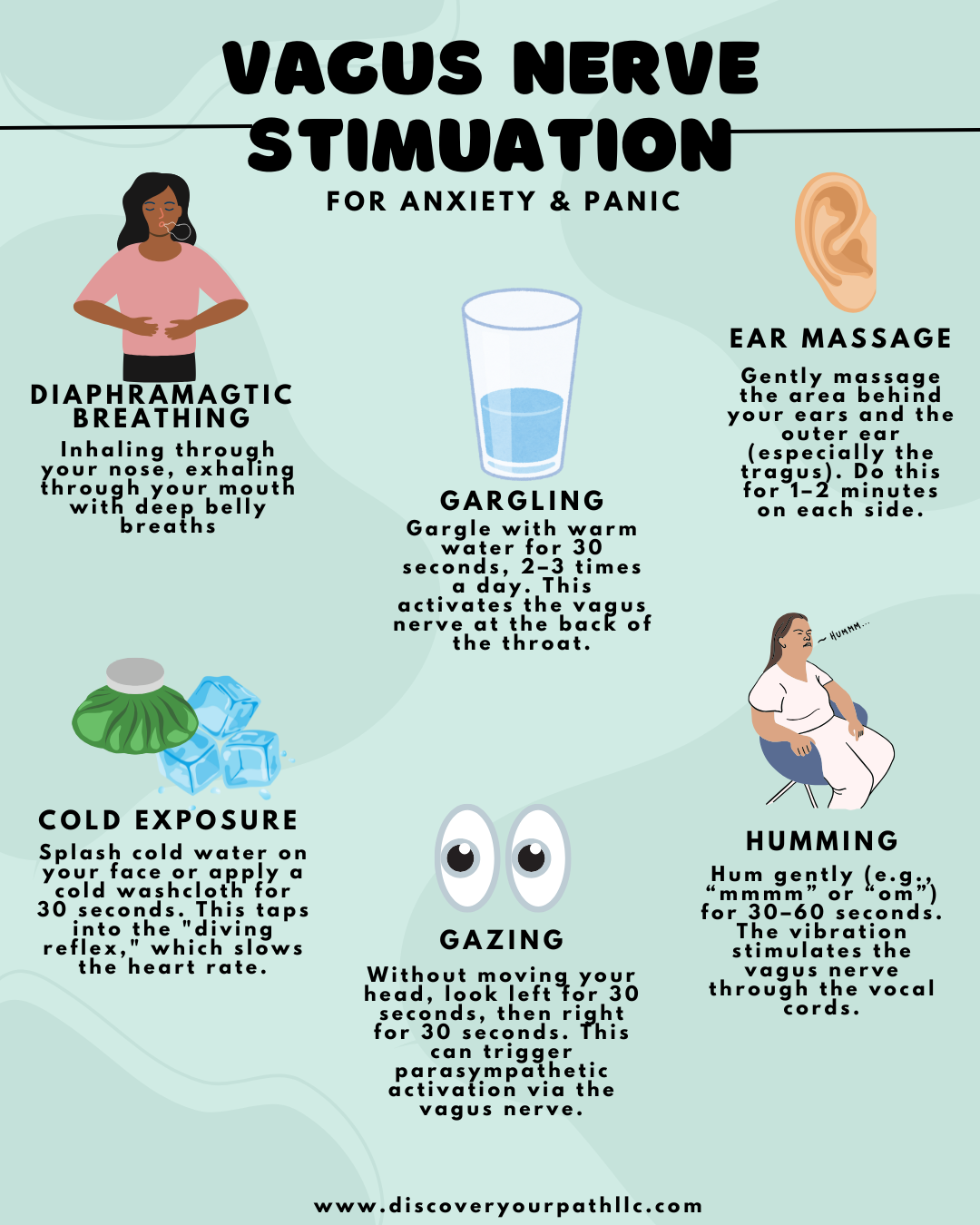How To Stimulate The Vagus Nerve for Anxiety Relief
Have you ever felt like your body is stuck in overdrive during a moment of stress, anxiety, or panic? Like your heart is racing, your breath is shallow, and there’s no “off” switch? That’s where the vagus nerve comes in, a powerful key to calming your nervous system naturally.
In this article, we’ll explore what the vagus nerve is, how it influences anxiety and panic, and simple science-backed ways to activate it, right from your home.
What Is the Vagus Nerve?
The vagus nerve is the longest cranial nerve in your body, stretching from your brainstem down to your abdomen. It’s a major part of the parasympathetic nervous system, the system responsible for resting and digesting, as opposed to fighting or fleeing.
Think of the vagus nerve as the body’s internal relaxation signal. When it’s activated (a state known as vagal tone), your heart rate slows, your breathing deepens, and your body starts to feel calm and safe. Poor vagal tone, on the other hand, is linked to increased anxiety, depression, inflammation, and difficulty regulating emotions.
Why Stimulate the Vagus Nerve?
For those struggling with anxiety or panic attacks, the nervous system tends to get stuck in a hyperaroused state, making it hard to settle down. Stimulating the vagus nerve sends a message to your brain: “You are safe.”
By regularly practicing vagus nerve stimulation, you can train your body to access calm more quickly and reduce the intensity and frequency of panic episodes.
6 Easy Ways to Stimulate the Vagus Nerve
1. Diaphragmatic Breathing (Belly Breathing)
Deep, slow breathing is one of the most effective tools to engage the vagus nerve. Focus on breathing from your diaphragm, not your chest.
How to do it:
Sit or lie down comfortably.
Place one hand on your chest and one on your belly.
Inhale slowly through your nose for 4–6 seconds, letting your belly rise.
Exhale slowly through your mouth for 6–8 seconds, letting your belly fall.
Repeat for 5–10 minutes daily or during moments of anxiety.
Why it works: Long exhales activate the parasympathetic system via the vagus nerve and lower your heart rate.
2. Humming and Chanting
The vagus nerve connects to your vocal cords, so vibrating this area through humming, chanting, or even singing can send soothing signals to your brain.
Try this: Hum a simple tune like “Om” or your favorite song for a few minutes. Notice the vibration in your throat and chest.
Why it works: The vibrations physically stimulate the vagus nerve and promote a meditative state.
3. Cold Exposure
Exposing your face or neck to cold can activate the vagus nerve and help snap your body out of a panic spiral.
Options include:
Splashing your face with cold water
Holding a cold compress to your chest or neck
Taking a cold shower or finishing your warm shower with 30 seconds of cold
Why it works: Cold exposure can quickly shift the nervous system from fight-or-flight to calm and regulated.
4. Eye Gazing
Moving your eyes from side to side — without moving your head — can gently activate the vagus nerve and signal safety to your brain. This technique taps into a process known as bilateral stimulation, which helps the brain process stress and shift out of a hyperaroused state.
How to practice:
Sit comfortably in a quiet space.
Without turning your head, slowly move your eyes to the far left, pause for a second, then move them to the far right.
Continue this side-to-side gaze for 30–60 seconds.
Keep your breathing slow and even throughout.
Why it works:
This movement pattern mimics the natural scanning motion we use when assessing our surroundings for safety. It’s thought to calm the amygdala (the brain’s fear center) and stimulate the vagus nerve by helping the nervous system shift from fight-or-flight into rest-and-digest.
5. Gargling
As odd as it may sound, gargling vigorously with water can help tone the vagus nerve by activating the muscles in the back of your throat.
Try this:
Gargle with water for 30 seconds to a minute, 1–2 times a day.
Try singing or humming immediately after.
Why it works: These throat vibrations stimulate the vagus nerve and help regulate the nervous system over time.
6. Ear Massage
Gentle massage around your ears can directly stimulate branches of the vagus nerve located near the outer ear (especially the tragus and concha areas). This soothing practice not only helps reduce tension but can also support vagal tone and relaxation.
How to practice:
Use your index finger and thumb to gently massage the outer ridge of your ear.
Focus on the area around the tragus (the small bump in front of the ear canal) and the inner fold of the ear.
Apply light, circular motions for 1–2 minutes per ear.
Breathe slowly and deeply as you massage.
Why it works:
The auricular branch of the vagus nerve runs through parts of the outer ear. Gentle stimulation of this area can activate the parasympathetic nervous system, promoting calm, reducing heart rate, and helping ease anxiety and overwhelm.
Final Thoughts: Small Habits, Big Calm
Your body holds built-in tools to regulate and soothe itself, if you know how to use them. By stimulating the vagus nerve through practices like deep breathing, humming, and cold exposure, you’re not only managing anxiety in the moment, you’re retraining your nervous system for long-term calm.
Make these practices part of your daily wellness routine and over time, you may notice:
Fewer panic attacks
Quicker recovery from stress
A greater sense of emotional resilience
You are not broken, your body is simply asking for support. The vagus nerve may just be the missing piece to unlocking your natural calm.
